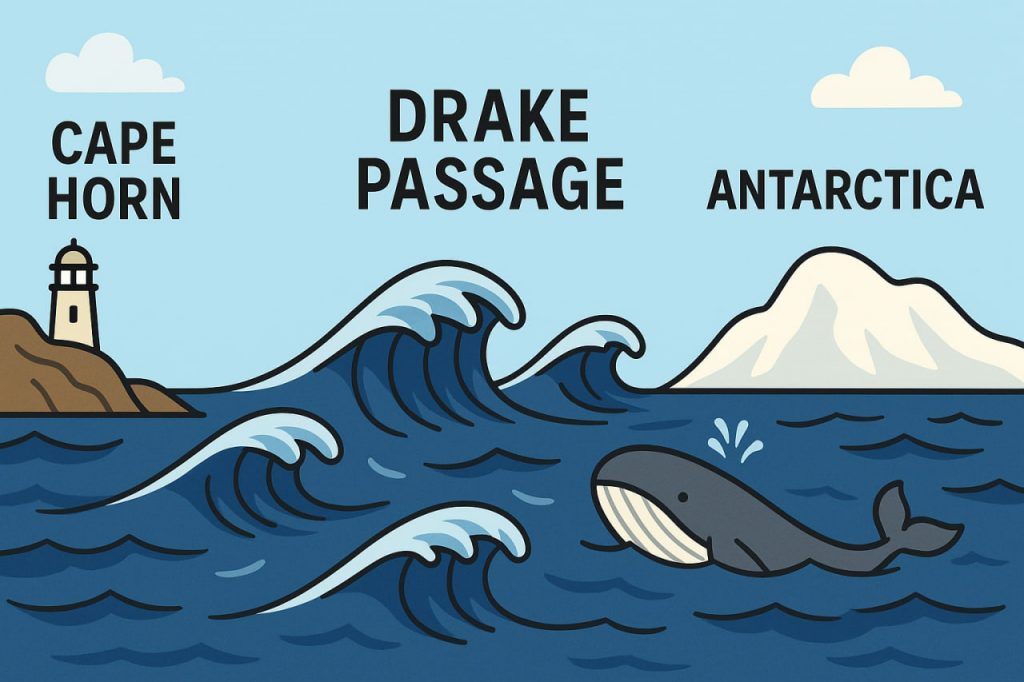The Drake Passage is a body of water that lies between the southern tip of South America (Cape Horn, Chile) and the northernmost part of the Antarctic Peninsula. It connects the Atlantic Ocean and the Pacific Ocean through the Southern Ocean. Spanning about 800 kilometers at its narrowest point, it is the shortest crossing from Antarctica to another continent, making it an important route for explorers and modern research vessels.
Historical Significance
The passage is named after the English navigator Sir Francis Drake, who sailed near the region in the 16th century. However, the first recorded successful navigation was made by Dutch sailor Willem Schouten in 1616. Before the construction of the Panama Canal, the Drake Passage was one of the only routes available for ships traveling between the Atlantic and Pacific Oceans. It became a crucial corridor for international trade and exploration, though often feared by sailors.
Harsh Climate and Conditions
The Drake Passage is notorious for its rough seas and unpredictable weather. Strong winds, massive swells, and powerful currents make it one of the most turbulent stretches of ocean in the world. Waves can reach over 10 meters in height, and sudden storms are common. These extreme conditions are caused by the uninterrupted flow of the Antarctic Circumpolar Current, which circles the globe and passes through this narrow gap.
Importance for Marine Life
Despite its harshness, the passage is rich in biodiversity. Nutrient-rich waters support vast populations of krill, a keystone species in the Antarctic food chain. These in turn sustain whales, seals, penguins, and seabirds. The Drake Passage also serves as a migratory route for many marine species, making it a vital part of Earth’s ecosystems. Its waters are protected under international agreements focused on preserving the fragile Antarctic environment.
Role in Science and Exploration
For modern scientists, the Drake Passage is both a challenge and an opportunity. Research vessels crossing it often study ocean currents, climate change, and Antarctic ecosystems. The region is crucial for understanding global thermohaline circulation, which regulates Earth’s climate. For adventurers and tourists, crossing the Drake Passage has become a rite of passage on expeditions to Antarctica, despite the discomfort of seasickness and rough voyages.
Strategic and Economic Aspects
Although the Panama Canal now handles most inter-ocean trade, the Drake Passage remains strategically important. It is free of icebergs for much of the year, unlike other Antarctic routes, making it relatively more accessible. With climate change opening new polar navigation possibilities, interest in the passage for shipping, research, and tourism continues to grow. However, strict environmental regulations limit commercial exploitation to protect fragile ecosystems.
Conclusion
The Drake Passage stands as one of the world’s most formidable sea crossings, known for its dangerous weather and historical importance. It links two great oceans while serving as a gateway to Antarctica. Although feared by sailors for centuries, it remains vital for science, exploration, and the understanding of global climate systems. Its legacy is a mix of danger, discovery, and ecological significance.
Glossary
- Drake Passage – a stretch of ocean between South America and Antarctica.
- Sir Francis Drake – English navigator after whom the passage is named.
- Antarctic Circumpolar Current – powerful ocean current flowing around Antarctica.
- Thermohaline circulation – large-scale movement of ocean water driven by temperature and salinity.
- Krill – small crustaceans that form the base of the Antarctic food chain.


